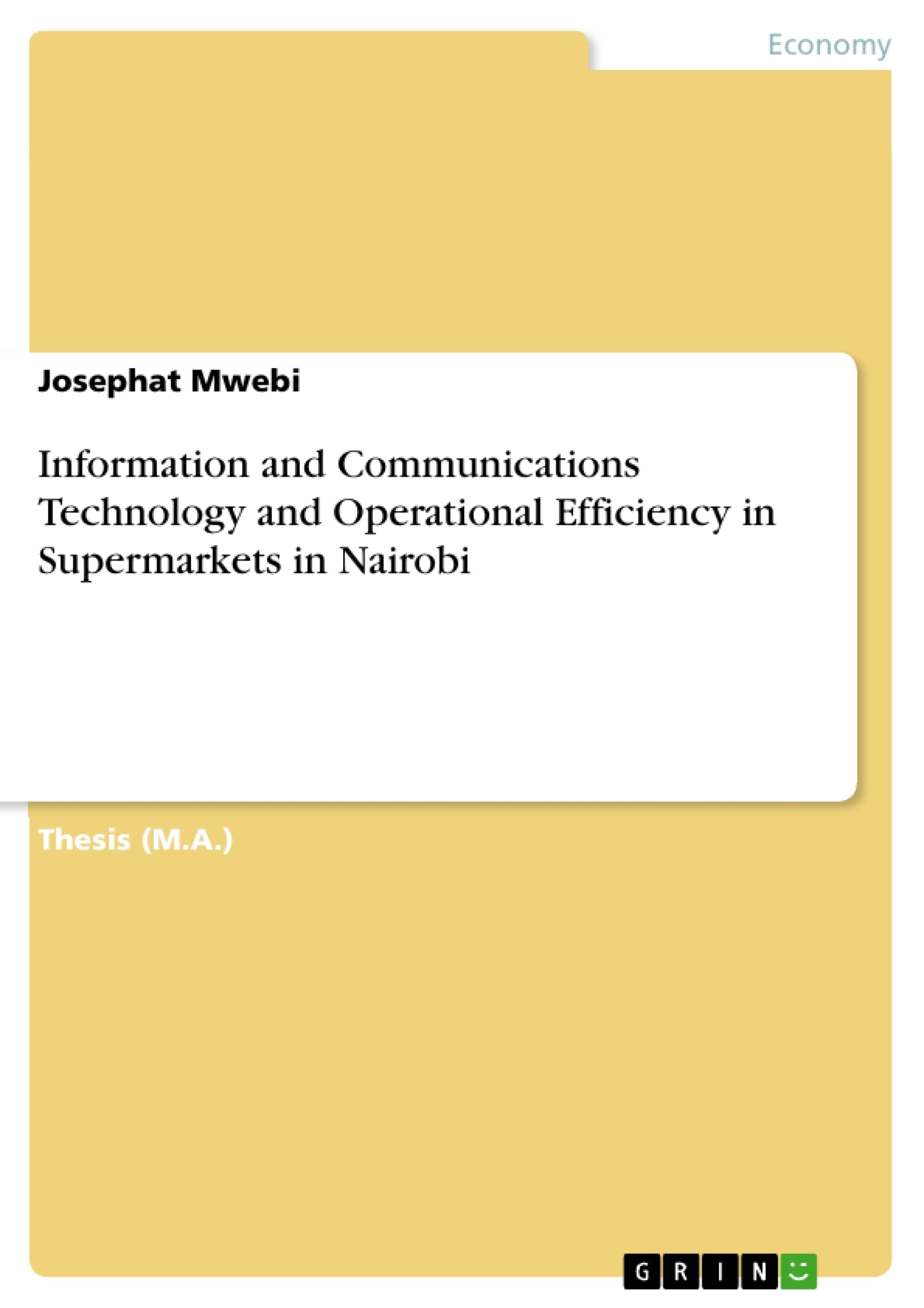The aim of this research was to find out the role of various ICT applications in the improvement of operational efficiency for supermarkets in Nairobi. It aimed to answer the questions of ICT applications that are adopted by supermarkets in Nairobi and the relationship between the level of adoption of these applications and operational efficiency that was attained.
A sample of 58 supermarkets was chosen from the list of 110 supermarkets to which structured questionnaires were issued by drop-and-pick method. The forty-two questionnaires were duly filled and returned. This constitutes 72.4% response which according to Stacks (2011) was adequate for use in analysing and presenting findings for the identified research objectives.
The findings indicated that applications that were simple and cheap to install and implement such as CCTV cameras, electronic point-of-sale systems and bar code readers were most prevalent while advanced and relatively expensive ICT applications such as ecommerce, supply chain systems and enterprise resource systems were least used. The size of supermarkets also determined ICT equipment that were used. Coefficient of correlation of 0.52 was obtained from the regression analysis that measured the strength of the relationship between dependent and independent variables. The relationship was direct, meaning that supermarkets with largest extent of ICT application in their premises had the highest operational efficiency.
It was recommended that supermarket owners acquaint themselves with ICT applications that are available in the market and evaluate those that are suitable for their needs. Supermarkets that had a wide array of application in their premises had high operational efficiency. It is therefore necessary that they use all available ICT applications depending on their needs. Given that some ICT applications were expensive to buy and implement, it was suggested that developers make applications that are suitable for local needs, with regard to supermarkets.
Inhaltsverzeichnis (Table of Contents)
- CHAPTER ONE: INTRODUCTION
- 1.1 Background of the Study
- 1.1.1 Operational Efficiency
- 1.1.2 Information and Communication Technology (ICT)
- 1.1.3 Role of Information and Communications Technology in Supermarkets
- 1.1.4 Supermarkets in Kenya
- 1.2 Statement of the Problem
- 1.3 Objectives of the study
- 1.4 Importance of the Study
- CHAPTER TWO: LITERATURE REVIEW
- 2.1 Introduction
- 2.2 Overview of Information and Communications Technology
- 2.3 Operational Efficiency in Supermarkets
- 2.4 ICT and Operational Efficiency in Supermarkets
- 2.5 Summary and conceptual framework
- CHAPTER THREE: RESEARCH METHODOLOGY
- 3.1 Research design
- 3.2 Target Population
- 3.3 Sample Design
- 3.4 Data collection
- 3.5 Data Analysis
- CHAPTER FOUR: DATA ANALYSIS, RESULTS AND DISCUSSION
- 4.1 Introduction
- 4.2 Demographic Data
- 4.3 Extent of ICT Adoption among Supermarkets in Nairobi
- 4.4 The relationship between ICT usage and operational efficiency in supermarkets in Nairobi
- 4.5 Discussion of results
Zielsetzung und Themenschwerpunkte (Objectives and Key Themes)
This research investigates the impact of Information and Communication Technology (ICT) on operational efficiency in supermarkets in Nairobi, Kenya. The study aims to understand the extent of ICT adoption in the supermarket industry, analyze the relationship between ICT usage and operational efficiency, and provide recommendations for improving efficiency through ICT implementation.
- The role of ICT in enhancing operational efficiency in supermarkets
- The extent of ICT adoption among supermarkets in Nairobi
- The relationship between ICT usage and operational efficiency in supermarkets
- Challenges and opportunities related to ICT implementation in the supermarket sector
- Recommendations for maximizing the benefits of ICT in improving operational efficiency
Zusammenfassung der Kapitel (Chapter Summaries)
Chapter One: Introduction provides an overview of the research topic, highlighting the importance of operational efficiency in supermarkets and the growing role of ICT in this sector. It outlines the research problem, objectives, and significance of the study.
Chapter Two: Literature Review delves into existing literature on ICT adoption and its impact on operational efficiency in the supermarket industry. It examines relevant theoretical frameworks and empirical studies to provide a comprehensive understanding of the topic. This chapter also presents a conceptual framework that guides the research.
Chapter Three: Research Methodology details the research design, population, sampling techniques, data collection methods, and data analysis procedures employed in the study. It provides a clear explanation of the methodological approach used to address the research questions.
Chapter Four: Data Analysis, Results, and Discussion presents and analyzes the collected data, providing insights into the extent of ICT adoption, the relationship between ICT usage and operational efficiency, and the key findings of the study. It offers a detailed discussion of the results, drawing connections between the findings and existing literature.
Schlüsselwörter (Keywords)
The research focuses on Information and Communications Technology (ICT), operational efficiency, supermarkets, Nairobi, Kenya, data analysis, quantitative research, survey methodology, adoption rates, challenges, recommendations, and the impact of technology on business performance.
- Citation du texte
- Josephat Mwebi (Auteur), 2013, Information and Communications Technology and Operational Efficiency in Supermarkets in Nairobi, Munich, GRIN Verlag, https://www.grin.com/document/441810



